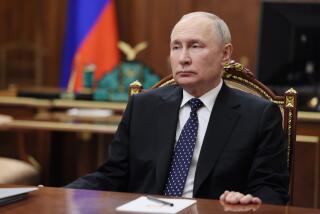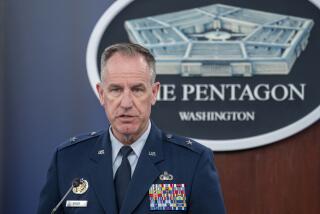Treaty Complicates Crowd Control
- Share via
WASHINGTON — The U.S. soldiers who opened fire on Iraqi demonstrators Monday night, possibly killing as many as 14 people, may have faced an international outcry if they had used nonlethal crowd-control agents such as tear gas instead of weapons of war.
Although the 1993 Chemical Weapons Convention allows the use of chemical riot-control agents for domestic law enforcement, it forbids their use in war. The U.S. is a signatory to the treaty and, technically, is still at war in Iraq.
Defense officials argue that it is absurd to permit troops to fire on a crowd with bullets and not tear gas. The Pentagon interprets the convention’s language to mean that such chemicals can be used to subdue crowds for their own safety or to defend U.S. troops. Defense officials authorized the use of tear gas during missions in Haiti and Bosnia-Herzegovina and have issued tear gas and pepper spray to U.S. forces in Iraq.
But many of the other 151 countries that signed the treaty, which seeks to outlaw chemical weapons, took a much stricter view of the rules at the time of its passage and would probably object strongly to their use in Iraq, experts say.
Many diplomats argued during the treaty debate that it can be difficult to differentiate between lethal and nonlethal chemicals.
They contended that a loose interpretation would open a loophole that might encourage some countries to use chemical weapons and justify them as a crowd-control tool.
“It all depends on who you talk to,” said Michael L. Moodie, a former diplomat who helped negotiate the treaty during the first Bush administration and is now president of the Chemical and Biological Arms Control Institute in Washington. “It’s just a murky area.”
He said the dilemma came about because the countries negotiating the treaty chose to leave the language ambiguous so they could craft an agreement they hoped would limit the spread of chemical weapons.
U.S. officials have interpreted the treaty in a way that makes it consistent with a presidential order first issued by Gerald Ford.
The order says tear gas should be available for certain defensive purposes, including the rescue of U.S. troops from a hostile environment and cases in which civilians are used as a screen for an enemy attack. The U.S. Senate, in ratifying the chemical weapons treaty, asserted as a condition that the convention must agree with the interpretation set out in the presidential order.
The use of so-called nonlethal agents became more controversial in October, when the Russian government overcame Chechen hostage-takers at a Moscow theater by pumping in a powerful gas intended to put the captors to sleep. The gas killed 127 theatergoers.
Pentagon officials have denied that the U.S. military has any similar “calmative” drugs in its inventories.
Defense Secretary Donald H. Rumsfeld testified before Congress in February that the Pentagon was working out guidelines for use of nonlethal riot-control agents. He complained that setting up such rules had become highly complicated because of the chemical weapons treaty and laws barring their use by U.S. forces in warfare without a presidential waiver.
Moodie argues that the U.S. government and its critics need to find a middle ground that will allow governments to defuse dangerous situations without opening the way to the use of deadly chemical agents.
This is becoming more urgent, he said, as science finds new ways to temporarily incapacitate people without harming them.
“What you have now is the two sides basically shouting at each other,” he said.
U.S. military officials said riot-control agents would not have been the answer to Monday’s shooting in the Iraqi city of Fallouja, because the incident involved demonstrators firing on U.S. troops. Residents deny that protesters fired on the soldiers.
“When people are shooting at the troops, they will defend themselves,” said Navy Lt. Cmdr. Charles Owens, a spokesman for the U.S. Central Command in Doha, Qatar. “That’s what happened here.”
More to Read
Sign up for Essential California
The most important California stories and recommendations in your inbox every morning.
You may occasionally receive promotional content from the Los Angeles Times.











